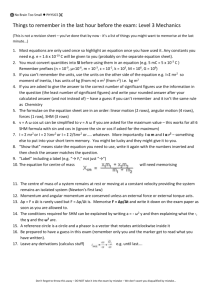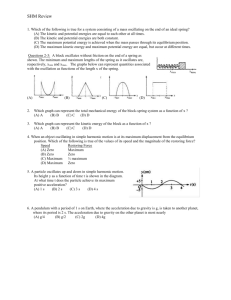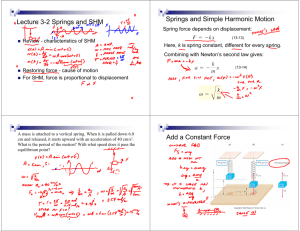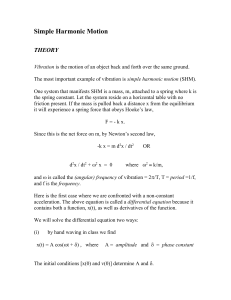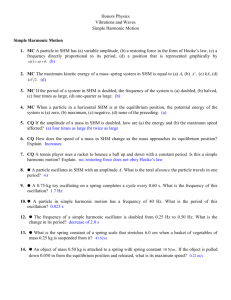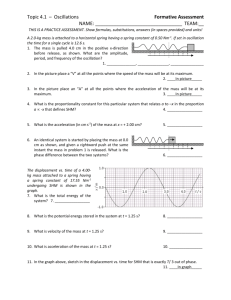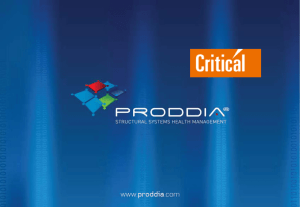Safety and Risk Management - Western Carolina University
advertisement
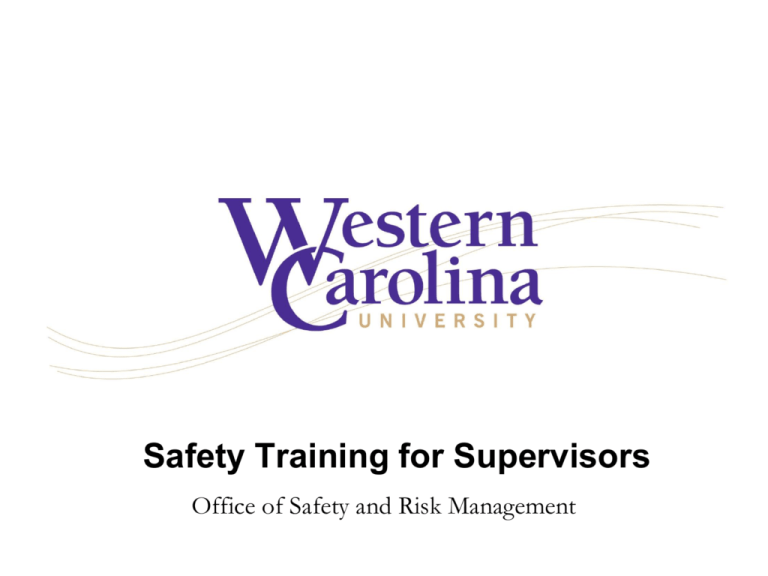
Safety Training for Supervisors Office of Safety and Risk Management As managers we sometimes forget that we can get into substantial trouble for not doing something. We spend so much energy focused on what we are doing that we overlook the consequences of what we’re not doing. Unfortunately, those consequences can be serious… Example Suppose you send an untrained employee to make a minor repair, and he or she electrocutes themselves. Or say an employee threatens a co-worker, but you decide you will deal with it when you “have time.” How will you explain yourself if the employee makes good on their threat before you “found the time” to deal with it? Consequences This situation is an example of negligent supervision: – the failure to meet accepted standards of care, resulting in harm to employees or the public. The law recognizes that supervision is serious business – lives may be at stake. Consequences Consequently, you can be held liable for damage that occurs because of negligent supervision. If you are held liable, the penalties can be substantial. But they are nothing compared to living with the knowledge that you could have prevented a tragedy. Understand the risks. Be vigilant. Take action. UNIVERSITY POLICIES Policy #44 Safe and Healthful Working Conditions It is the policy of Western Carolina University to provide safe and healthful working conditions for its employees. The University Safety and Health Program is intended to: – serve that policy objective – achieve compliance with statutory mandates which impose standards related to occupational safety and environmental health. Policy #44 The program’s effectiveness depends upon the awareness and active participation of all employees on campus: • • • • Faculty members Staff employees Administrators Student employees Policy #44 The workplace cannot always be risk free. However, through work planning and management, the safety hazards associated with jobs can usually be identified, and safety measures can be applied to eliminate those that are controllable. It is a basic responsibility of unit supervisors to know the safety and health procedures that are required: – instruct their employees – provide equipment to do the job safely – monitor compliance Employees have an obligation to follow safety procedures and to use safety equipment. Policy #44 The University Safety and Health Program Manual contains: – Organizational structure – Policies – Procedures Deans, directors, and department heads should familiarize themselves with this manual and work closely with the campus Safety and Risk Management Office on specific safety and health matters to ensure that compliance is achieved and maintained. Initially approved May 1, 1991 Administering Office: Safety and Risk Management (Facilities Management) SAFETY AND RISK MANAGEMENT TRAINING FOR SUPERVISORS This program briefly summarizes the contents of the Safety and Health Program Manual (SHM). When applicable, the sections of the *SHM is referenced in the bottom left corner. The SHM will provide a more detailed explanation. Where to find them… SAFETY & RISK MANAGEMENT http://www.wcu.edu/11808.asp PHONE NUMBER: 227-7443 Facilities Management Building 3476 Old Cullowhee Road Cullowhee NC, 28723 The Safety and Risk Management office is responsible for assessing the risk exposures associated with university facilities and establishing programs to control the risk of accidents, fires, environmental, health exposures, financial losses, and comply with safety and environmental regulations. SCOPE OF RESPONSIBILITIES • Occupational Safety and Health (OSHA) • Environmental Protection Procedures (EPA) • Safety Procedures / Policies • Building Fire Safety • Risk Management • Insurance Administration • Workers Compensation SUPERVISOR RESPONSIBILITIES • Know the University Safety & Health Procedures that apply to your work unit. • Make sure proper equipment is available for tasks. • Train workers in applicable safety procedures. • Enforce safety rules. • Report & Investigate Complaints and Accidents. • Know the safety risks of processes within your responsibility. • The Safety and Health Program is the responsibility of each employee, supervisor, and administrator. *SHM 01 and 02 EMPLOYEE RESPONSIBILITIES • Place safety and health requirements as the first importance of your work duties. • Follow safety rules as instructed by the supervisor. • Report a violation or deficiency in safe and healthful working conditions, and for recommending corrective measures, if possible. • Report all injuries and accidents to the immediate supervisor. *SHM 01 and 02 Safety should fall under the category/expectation of Judgment on the Employee Performance Evaluation. Use this category to cover Safety Performance EMPLOYEE REPORTING OF SAFETY CONCERNS • Employees are encouraged to seek resolution of hazardous conditions through the Safety and Risk Management Office. • Employees have the right to request an inspection from N.C. Department of Labor (OSHA) by giving notice to them of a violation of a safety or health standard that threatens physical harm or constitutes immediate danger. • Employees may request confidentiality and are protected by law from retaliation. • The Safety Office will give notice of findings to the employee and department. • Examples of Concerns: • Unsafe Work Practices • Environmental Hazards • Unsafe Conditions or Equipment • Fire Hazards *SHM 03 REPORTING ACCIDENTS • Report accidents to Safety and Risk Management as soon as possible. • Report suspected occupational illness whenever you are informed by physician report or employee. • Report close calls even if there is no injury or damage. • Safety Office will follow up with an investigation. • Report time lost from work because of an accident or illness or unexplained absences from work. • Immediate supervisor of the employee are responsible for determining the cause of the accident and forwarding the Employee Statement form to the Safety Office. • Supervisors in charge of daily work activities are expected to know what happened, why it happened, and how it happened. • Do not discuss fault or promise to pay for expenses. *SHM 04 and 05 You are an “agent” of the University, so “Official Notification” takes place whenever You are told about an accident or unsafe condition. SAFETY INSPECTIONS • The Safety and Risk Management Office conducts an annual internal inspection. • Any employee who has a direct personal involvement has the right to accompany the inspector. • The Department of Insurance conducts an annual fire safety inspection. • OSHA / EPA will also conduct an inspection as the result of a serious accident or may conduct a routine inspection. Reports of discrepancies are forwarded to the building coordinator or responsible department. *SHM 06 PURCHASING SAFETY RELATED EQUIPMENT AND HAZARDOUS MATERIALS • To assure proper safety, features are included in equipment and for hazardous materials. • Coordinate with the Safety Office when purchasing certain items. Example Purchase of: • • • • • *SHM 08 Safety Equipment Acutely Hazardous Chemicals Shop Machinery Construction-type Equipment A complete list is in the SHM procedure #8 EMPLOYEE SAFETY TRAINING • New employees must be instructed in safety procedures and concerns that apply to their jobs. Examples: - Emergency procedures - Chemical hygiene and hazards - Ergonomics • Human Resource’s Orientation does not cover specific job safety training. • A few subjects also require annual refresher training - Example: Bloodborne Pathogens • Document training and keep records. • The Safety Office provides training support if needed. *SHM 09 FIRE SAFETY • No aisle, exit access, or stairway in any place of occupancy shall be obstructed with tables, show cases, or other obstructions so as to reduce its require width as an exit. • Storage of materials on stairs, landings, or under stairs is strictly forbidden. • Do not prop open stairwell doors. • Contact Safety and Risk Management for approval of extra portable seating in classrooms and assemblies. • Departmental sponsors of large public assemblies (more than 100 persons) are responsible for emergency planning and supervision of the event. • Contact Safety & Risk Management for ceremonies using open flame or pyrotechnics. *SHM 11 and 13 FIRE SAFETY (continued) • Maintain good housekeeping. • Do not use Mechanical Rooms or hallways for storage. • Coordinate the use of live Christmas trees with Safety and Risk Management. • Unplug or turn off all appliances at the end of the day. • Do not use excessive extension cords as permanent wiring. • Space heaters are prohibited. • Use of volatile chemicals require special handling and storage procedures. *SHM 11 and 14 ERGONOMICS • Plan job duties to minimize repetitive body motion. • Arrange storage and furniture to avoid excessive lifting and carrying. • Ergonomics of extended computer use: – Frequent breaks to stretch – Wrist/Arms at 90º and supported – Back Support and feet on the floor – Reduce screen glare – Keep screen 18” from eyes and directly in front of you • Diversify jobs to minimize repetition and vibration. • Report complaints of Musculoskeletal Pain. *SHM 20 SAFETY EQUIPMENT FOR EMPLOYEES • Eye protection is required in jobs with exposure to flying objects, chemical splash, welding etc. • Prescription safety glasses for frequent users, goggles over glasses for occasional users. • Face shields do not meet eye protection standards and are only for face protection. • Safety shoes for: – occupations that lift and carry items greater than 15 lbs – construction jobs • Respiratory protection for jobs with a possible inhalation hazard: – Medical evaluation required – Fit test required – Training required *SHM 21 thru 23 CHEMICAL USE • Maintain labels and material Safety Data Sheets for all substances. • Know the basic hazards. • Know safe handling practices. • Instruct employees in hazards. • Provide protective equipment (gloves, eyewear, etc.). • Maintain adequate ventilation. Do not use a material if you are not absolutely sure of what it is! *SHM 24 thru 25 REGULATED HAZARDOUS WASTE Chemicals (solid or liquid) that are: – – – – Ignitable Corrosive Reactive Toxic These Chemicals should not be poured down a drain or placed in ordinary trash. They should be collected by Safety and Risk Management. If in doubt call the Safety and Risk Management Office. *SHM 26 EXAMPLES: • Oil Base Paint • Wood Finisher and Paint Thinner • Glue (Commercial Quantity) • Inks • Concentrated Cleaners in Bulk • Pesticides *SHM 26 TOXIC “LEACHERS” • Some common items which are not ordinarily thought of as harmful when handled are hazardous waste because they leach small quantities of toxic materials over time in a landfill. Examples: – Batteries – Circuit Boards – Thermostats – Scrap Metals – TV’s and Electronics These items require special handling and should be recycled. *SHM 26 ASBESTOS • Asbestos is a mineral based composed of small thin fibers. • Common mineral found in rocks. • Is a proven human carcinogen. • Very durable, heat, water, and chemical resistive • Common in floor tile and pipe insulation found in older structures. – Buildings built before 1980 (List in the SHM) – Only hazardous if disturbed Report suspected hazards and leave it alone until it is evaluated! *SHM 27 SHOP SAFETY • • • • • • • • • Maintain Machine Guards Provide First Aid Kits Provide Eye Protection Electrical Safety Ventilate Excessive Dust Coatings can be a Health Hazard Keep Gas Cylinders Secure Dust Control Flammable coatings, adhesives, and paints • Tool Safety *SHM 28 EMERGENCY PLANS Emergency #911 or Campus ext. 8-911 • Provide name, location, and nature of emergency. • Pull fire alarm to alert building of a emergency (if needed). • Secure appliances, close door. • Use stairs never elevators • Help people with disabilities. • When fire alarm signals are activated occupants are to evacuate the building until instructed to re-enter. • Person(s) knowledgeable in the area where the emergency occurs should meet the responding emergency personnel. • Once outside the building, report to designated locations in accordance with department plans. Workers Compensation • WCU is self-insured for all Worker’s Compensation costs. This means WCU is responsible for paying for the medical costs, and in some cases weekly benefits associated with each work-related injury. • A third party administrator (TPA) contracted by the State of North Carolina, handles the individual worker’s compensation cases for the University System. The current TPA is Corvel Corporation located in Charlotte, NC. • The TPA is responsible for accepting or denying liability for the State and is responsible for the management of and processing of claims. • All WCU employees are covered under the State Worker’s Compensation program, including full-time faculty, staff, senior administrative officers, part-time employees, student employees, and temporary employees. *SHM 05 Worker’s Compensation Benefit Overview • The program provides two thirds (2/3) of wages as long as unable to work, first seven (7) days sick/vacation leave, can supplement workers compensation with two (2) hours sick/vacation leave a week. • Continue to accumulate sick/vacation leave while on Worker’s Compensation leave. • Health Insurance coverage under the State’s Health Insurance program continues. • No retirement service credits while on Worker’s Compensation leave. Employee can purchase credits for the period missed. • Pays medical cost and disability benefits for work related injuries, Occupational Illnesses. • The treating physician must be approved through Corvel. Workers Compensation (continued) Supervisor Responsibilities: • Report all work related injuries to the Safety Office as soon as you’re notified by the employee. • Refer employee to University Health Center for initial treatment of nonlife threatening injuries. If University Health Center is closed, refer employee to MedWest Urgent Care (Next to Walmart in Sylva). Call 911 for life threatening employee injuries. • Notify the Safety Office immediately if the employee begins missing time from work. Forward all work notes to the Safety Office. • Have employee and supervisor statement forms completed and returned to Safety Office in a timely manner. • Assist the Safety Office with identifying modified duty work for employees who are able to return to work with restrictions. • After return to work, ensure time taken for approved medical treatment and rehabilitation is not charged to leave. *SHM 26 Worker’s Compensation Contact Jamie Hilton Safety & Risk Management 227-7443 Email: JLHILTON@email.wcu.edu *Contact for initial injury reports, or questions regarding Worker’s Compensation. FIRE INSURANCE • All buildings and contents have fire, lighting and extended coverage (windstorm and hail) coverage. • “All Risk” and other special coverage can be purchased for special conditions or highly valuable contents. This will cover everything including theft with a $5,000 deductible. • All Risk insurance requires a list of property covered. The cost of all risk is charged to the department. VEHICLE INSURANCE • Vehicle liability insurance is provided for all State owned vehicles through Travelers Insurance. • The amount is $1,000,000 per claim, $10,000,000 aggregate. • Travelers also provides comprehensive and collision. This is optional at the Department’s expense. • All department owned vehicles including carts will be covered with the policy. • Safety Office must be notified to add coverage for any vehicle or cart. VEHICLE INSURANCE continued • The accountable officer decides who is authorized to drive department vehicles, which is generally any State employee with a valid drivers license. • Those who drive 15 passenger vans are required to attend Van Driver Safety training. Contact Safety and Risk Management Office to schedule training. • Short term (<30 days) leased vehicles are covered by the leasing company’s insurance. Collision damage coverage is provided by the State policy. • Traveling Abroad? - Call Safety and Risk Management Office for information. OTHER INSURANCE PROGRAMS • Health and accident insurance for individuals participating in summer camps • Health and accident insurance for students who study abroad • Excess liability to protect state employees while performing their jobs • Loaned artwork and exhibits insurance • Liability for student interns • Outfitters and guides liability for fieldtrips • Athletic Accident Insurance Congratulations! You have reached the end of this presentation. Should you have any additional questions regarding the information presented here, please call the Office of Safety and Risk Management at 227-7443.

